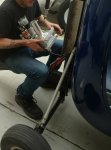All_In
Gold Supporter
- Joined
- Apr 21, 2008
- Messages
- 16,105
- Location
- San Diego, CA. USA
- Aircraft
- Airgyro AG915 Centurian, Aviomania G1sb
- Total Flight Time
- Gyroplane 70Hrs, not sure over 10,000+ logged FW, 260+ ultralights, sailplane, hang-gliders
We have two prerotartor projects in the works. This first project completed by San Diego University senior engineering students used low tech car starter but they have created a two-speed ball transmission for low and high gear. All of the Solid work drawings, CNC code will be provided to either create your own or PRA will explore having them made for you. In either case, you will want to buy the parts from PRA as we plan on buying volume and holding it in inventory reducing the cost to members.
They are now creating a 2nd unit that we will install on an RAF our test platform with 30' blades for long term testing. You can expect 180 to 250 RRPMs as we are changing the 2nd gear ratio for even more speed.
If weight is a problem do not rush into building this model. Another college San Diego State University is building a lightweight one using a more powerful state-of-the-art motor with no transmission.
Also, another SDSU PRA team is building a 'G' impact fuel cut-off switch we hope will reduce the fire danger.
Stay tuned for full testing of the 1st car starter transmission version and then 2 new PRA Open source project coming soon.
They are now creating a 2nd unit that we will install on an RAF our test platform with 30' blades for long term testing. You can expect 180 to 250 RRPMs as we are changing the 2nd gear ratio for even more speed.
If weight is a problem do not rush into building this model. Another college San Diego State University is building a lightweight one using a more powerful state-of-the-art motor with no transmission.
Also, another SDSU PRA team is building a 'G' impact fuel cut-off switch we hope will reduce the fire danger.
Stay tuned for full testing of the 1st car starter transmission version and then 2 new PRA Open source project coming soon.

